Softening apparatus
a technology of softening apparatus and softening chamber, which is applied in the direction of grey water treatment, water/sewage treatment by ion exchange, water/natural treatment water, etc., can solve the problems of contaminated electric home appliances, inability to fundamentally remove hardness components, and deterioration of cleaning performance, etc., to achieve convenient and inexpensive effects
- Summary
- Abstract
- Description
- Claims
- Application Information
AI Technical Summary
Benefits of technology
Problems solved by technology
Method used
Image
Examples
Embodiment Construction
[0039]Reference will now be made in detail to the embodiments of the present disclosure, examples of which are illustrated in the accompanying drawings, wherein like reference numerals refer to like elements throughout.
[0040]Embodiments of the present disclosure relate to a softening apparatus that softens raw water containing a hardness component. For convenience of description, the present disclosure describes different forms of water as follows: water containing a hardness component introduced into the softening apparatus is referred to as raw water; raw water, from which the hardness component has been removed, discharged from a softening unit is referred to as soft water; water having a high concentration of hydrogen ions (H+), generated by an anode during electrolysis, and supplied to an ion exchange body is referred to as regeneration water; water having a high concentration of hydroxyl ions (OH−), generated by a cathode during electrolysis, and discharged from the softening ...
PUM
| Property | Measurement | Unit |
|---|---|---|
| shape | aaaaa | aaaaa |
| structure | aaaaa | aaaaa |
| hardness | aaaaa | aaaaa |
Abstract
Description
Claims
Application Information
 Login to View More
Login to View More - R&D
- Intellectual Property
- Life Sciences
- Materials
- Tech Scout
- Unparalleled Data Quality
- Higher Quality Content
- 60% Fewer Hallucinations
Browse by: Latest US Patents, China's latest patents, Technical Efficacy Thesaurus, Application Domain, Technology Topic, Popular Technical Reports.
© 2025 PatSnap. All rights reserved.Legal|Privacy policy|Modern Slavery Act Transparency Statement|Sitemap|About US| Contact US: help@patsnap.com



